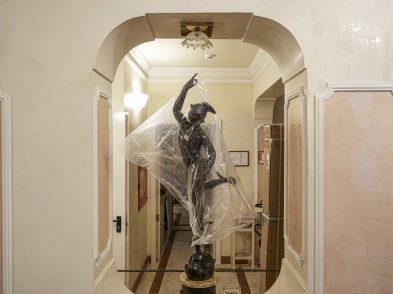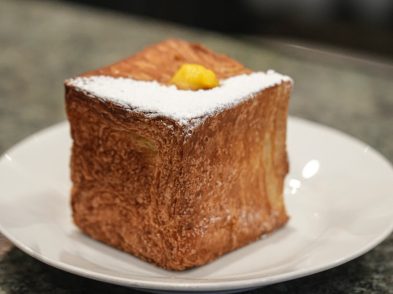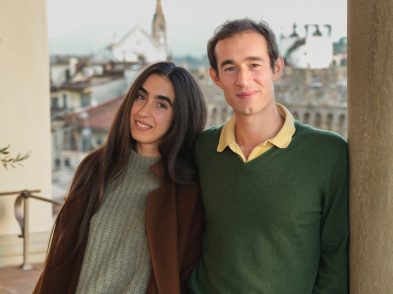Guides, bloggers, food-lovers and critics consider Marco Stabile, head chef at Ora d’Aria restaurant on via Ghibellina, one of the most important chefs in Florence. His restaurant has grown with patience and dedication; sustained and promoted by proprietor Luca Bellandi, and by his own excellent work. We invited him to talk to us about life as a Tuscan chef, and he joined us in The Florentine’s press office one sweltering afternoon after returning from Scarperia, where he had been checking on the progress of some of the knives he designs. Despite the heat, he immediately started talking about how the profession encourages young chefs to travel to grow, experiment, open their minds and try many kitchens and many different countries. We picked up the conversation form there.
Chefs are notorious for traveling to learn. Tell us about your training.
I have worked in numerous Tuscan restaurants, and in France, with the added bonus of a stint in Sonoma, California, which is near the Napa Valley. Unfortunately, in the Italian culture, the idea of ‘wandering’ while learning until you find your niche doesn’t exist. Perhaps only the chefs do it. In other cultures, it is completely normal in other professions. Especially in eastern cultures: Japanese and Koreans come here to learn the artisan and artistic trades like goldsmith, ancient crafts and cooking.
And then one comes back with a bunch of new information and new ideas?
Yes, but our public doesn’t love new ideas! Often times the creativity that we gain through our contact with different cultures becomes something just for us, just for us chefs.
So the new creativity is not welcome in the kitchen? What are your Florentine and Italian patrons like?
Well, over the last three years I immediately started preparing new dishes, new combinations but then I went back because the clientele wasn’t there for that, now I’ve started adding smaller new things, almost invisible, for those who can perceive them, to a more ‘normal’, meaning ‘good’ cuisine done in a new way but still reassuring. I think that Italians still consider going out to eat an event rather something fun to do any day of the week. Think of birthdays, special occasions, celebrations. They don’t go out to eat often and so they don’t want to make a mistake, to mess up-they aren’t as curious about trying new things because tomorrow they are going to try something different so it doesn’t matter. They are looking for food they already know and like.
Abroad, in France for example, going out to dinner is a usual habit. Is it just more traditional here?
Florentines tend to go to places with ribolitta and bistecca alla fiorentina but even with fish they tend towards simplicity and a special element about a certain fish isn’t appreciated. I think we actually have a bit of a complex about this!
Do you feel at all stifled because of that?
At the beginning it was really traumatic! I was discouraged. I am creative, but not in the sense that I must mix always try new things to be happy: I learned that I like to make subtle changes, and that I want to offer a few new elements to give some movement to Florence’s gastronomic culture, which has been a bit stuck, and to stimulate food and wine tourism. Now I have fun working with more classic dishes that appear ‘normal’ at first glance but have something exciting.
Like what?
Well for example, I just created a limited edition menu based on porcini mushrooms from the Casentino where the dishes are simple but the techniques are advanced. Cooking time and consistency are innovative where you can bring out the best flavors even in a cut of meat.
So you found your creative space by creating ‘understandable’ recipes?
My cooking is very understandable but very avant-garde at the same time.
Can you give us an example?
A porcini mushroom soup with guinea fowl cappelletti and summer truffles. This dish is being talked about a lot right now. It looks like a normal dish. But the mushroom is divided into five parts, every part is cooked differently and then they come back together on the plate. They are all porcinis but with five different flavors brought out by the different cooking process. If I didn’t tell you, you would be presented with a dish that seems ‘traditional’ until you taste it.
What is it like to have one of your dishes reviewed by a critic or a blogger (increasingly important in the 2.0 web age)?
I’m happy to read reviews, both positive and negative. Negative reviews help me stay within the limits and correct myself. Positive reviews are also great as it means I have hit the mark.
How important is it to have accolades from the so-called food lovers who write for a living? Are they an important part of the clientele? Do you create special dishes or try new things for them?
They are an important, certainly. I am not really one to do public relations, I don’t know how to sell myself, so to speak. But I am happy that over the last seven months I have had visits from some of Italy’s most important ‘foodies’, without me knowing about it. They help me and they are very positive about Ora d’Aria, in a very natural way because the reviews are based on what I cook and not what I say.
You haven’t told us about your tourist or non-Florentine patrons…
I am not sure I have a response for that, but I can tell you that the people that come to the restaurant now are changing. The more curious are coming, because they’ve heard about it, they see me at events. I do a lot of tasting menus which are the realm of curious eaters. They are menus of five to seven dishes that are comforting to the client because of their fixed price. Up until a year ago more tourists and not Florentines, ordered the tasting menu, now it’s a little more varied.
So a tasting menu means investigating in a certain sense?
If you notice you’ll see that not many restaurants in the center, the more traditional places, do tasting menus. It is actually a great tool in really understanding a restaurant’s quality. We had three permanent tasting menus, now we’ve added another limited edition one for a short time-like the Casentino porcini mushroom.
We’ve seen from the Ora d’Aria newsletter that you constantly change your menu.
We change it every two months. From the moment we change, I am already studying the next one. There are three days of overlap between the two menus, which is a really crazy time for us in the kitchen!!
Does a menu change do more for the clients or for the chef?
In my case it does more for me! I will serve similar dishes during the seasons but I never do the exact same one twice, I try them with new things. A dish can always be looked at in a different way and studied again.
Talking with you about menus and preparing a dinner we often hear you mention the sensory aspect of food. How important is it?
Well the raw material is the most important thing, when I buy it I have to feel something. If I buy it, it becomes mine. This is a great moment right now because my entire kitchen staff is in love with what we are cooking right now-I actually have to stop them from eating everything! This is important because whoever is cooking transmits their feelings and sensations onto the dish. Having this basis is the best, through technique and combinations you can give the dish the translation of that which makes me want to eat it. I am convinced that I transmit something in my dishes. You eat the same dish from different chefs, with the exact same ingredients, but the client will taste a difference. You will feel my emotions in the dish.
Where do you get your raw material? Do you have any particular markets where you find especially good products?
My greatest discovery in Florence has been the Officina di Santa Maria Novella where I get spices and alkermes that I don’t just use for desserts. Of course the Sant’Ambrogio market is a favorite for fresh vegetables. I get my meat from Piedmont from a supplier that I know and who’s methods I have seen personally. He only uses thigh cuts.
Your menu always mentions the Paolo Parisi eggs you use. Why does such a simple product have a brand name?
I buy 140 of his eggs every week and I use them in everything. They come from Category One free-range hens from Parisi’s farm. In addition to corn, he feeds them goat’s milk. The protein gives them a different consistency and the yolk has an almond flavor to it.
Do you have a favorite Florentine recipe you like to experiment with?
I recently read one of Leonardo Romanelli’s blogs where he said that he was going to go out and see who was still making ribollita since cavolo nero is out of season. I wrote him and told him that I would make it but that it would be ‘seafood ribollita’. He was curious, so I made it by substituting the cabbage flavor with seaweed. It turned out amazing and people really liked it!
We know that you are dedicated to many projects, both volunteer and otherwise. What has your experience been with the ‘sociality’ of food, the interaction with others and the transmitting of your knowledge?
It is really about bringing out my thoughts, what I consider to be my art. I am honestly happier teaching a child with Down syndrome or someone at the jail in Volterra, or hosting special guests in my kitchen than I am teaching another chef who may then turn around and pass it off as his or her own. I prefer to donate myself to kids and am really moved when one of them learns how to do something and he hugs me and thanks me with a smile. They are only interested in being with you and understanding what you are giving them.
So you don’t give cooking classes?
I teach in three professional schools, in Montecatini, Arezzo and Iesi. Iesi is a slow-food school, which is particularly interesting for me.
What are your plans this summer?
First I’m doing an event at the Forte Village Resort in Sardegna, then I’m going back to Beaver Creek, Colorado to continue the cultural exchange we began earlier this year. [See our special ‘Wine and Fashion Florence‘ issue]
Where do you go to eat when you aren’t cooking?
My mom’s house! I go back to Pontedera every two weeks. She is my biggest inspiration. I also often go to my supplier’s houses for dinner.
Thanks, Marco, you’ve helped us to appreciate your art through your words. Seeing as we are in the city of the Medici, we would like to do things the way they did them: we’ve hosted an artist, and now we will ask him to leave us one of his works. Would you share a recipe with The Florentine’s readers?
Marco was gracious enough to say yes, and sent the following recipe, made expressly for us!
BACCALÀ AND CHICKPEA ‘EGG’
Marco Stabile’s receipt for The Florentine
4 egg shells, well cleaned and emptied through a small hole on one side
50 g soaked codfish boiled in water and laurel
150 ml skim milk
40 g isinglass (best to use 4 grams of agar if you can find it)
50 g boiled chickpeas made into puree
2 g turmeric or powdered saffron
1. Bring the milk, codfish and the isinglass (previously soaked with the agar) to a boil for approximately 3 minutes. Blend the mix with a hand blender and fill the egg shells halfway. Make 4 balls with the chickpea puree, add the turmeric or saffron, and put it in the shells. Fill to top with another spoonful of codfish compote. Chill for 20 minutes.
2. Peel the ‘egg’ as though it were hard-boiled and cut the contents lengthwise into two pieces with a warm knife. Serve it on a plate with some fresh baby lettuce dressed with extra-virgin Tuscan olive oil, salt and balsamic vinegar from Reggio Emilia.








